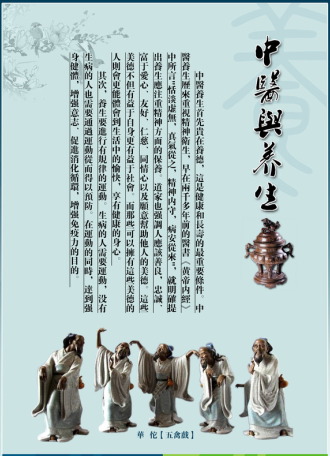Heat (fire) is the predominant climatic factor in summer. So disease due to pathogenic heat (fire) usually occurs in summer. However it can also be encountered in other seasons. Since there are two ways to describe the order of pathogenic factors in Huangdi Neijing, namely "wind, cold, summer-heat, dampness, dryness and heat" and "wind, cold, summer-heat, dampness, dryness and fire", so "fire" and "heat" are often mentioned in the same breath. If we make a comparison between the fire and the heat, we can say that the heat is the manifestation of the fire and the fire is the nature of the heat. They are, to a certain degree, different from each other but intrinsically related to each other.
The following is a brief description of the nature and the characteristics of heat (fire) in causing disease:
Tend to Flame Up
Heat (fire) pertains to yang and tends to flame up. So the disease caused by the pathogenic heat (fire) is marked by high fever, aversion to heat, extreme thirst, sweating and full pulse. When the pathogenic heat (fire) attacks the body, it may disturb the mind, leading to dysphoria, insomnia, mania, coma and delirium, etc. Since the pathogenic heat is responsible for irritability and rapid movement, the disease caused by it is characterized by acute onset and rapid transmission.

Tends to Consume Qi
Heat (fire) pertains to yang and tends to consume yin-fluid. If there is superabundant heat, it will drive body fluid out of the body in the form of sweat. So the disease caused by the pathogenic heat, apart from the manifestations of heat, is often accompanied by thirst with preference for drinking water, dry throat and tongue, dark and scanty urine and retention of dry feces due to consumption and impairment of body fluid.
Huangdi Neijing says that "strong fire consumes qi". The pathogenic heat (fire) is strong fire, so it consumes the healthy qi. Besides, profuse sweating due to exuberance of heat also impairs the healthy qi. So at the late stage of febrile disease healthy qi is still deficient though the pathogenic factors have already been eliminated.
Tend to Produce Wind
When heat (fire) invades the body, it usually scorches the liver meridian, consumes body fluid and deprives the tendons of moisture and nourishment, leading to occurrence of liver-wind with the manifestations of high fever, epistaxis, coma, delirium, convulsion of the four limbs, staring straight upward, stiff neck and opisthotonus.
Blood coagulates with cold and moves fast with heat. But if the heat is excessive, it will drive blood to flow very fast or scorch the vessels or even compel blood to flow out of the vessels, leading to various hemorrhage, such as hematemesis, hematochezia, hematuria, eruptions, profuse menorrhea and sudden profuse uterine bleeding.
Tend to Cause Swelling
When heat (fire) invades blood phase and accumulates in local area, it will putrefy blood and muscles, causing abscess, furuncle and ulceration. These kinds of problems are marked by redness, swelling, heat and pain which are the manifestations of heat (fire). Heat (fire) responsible for abscess, furuncle and ulceration is called heat (fire) toxin. That is why it is said in TCM that "abscess and furuncle are caused by fire-toxin'.







